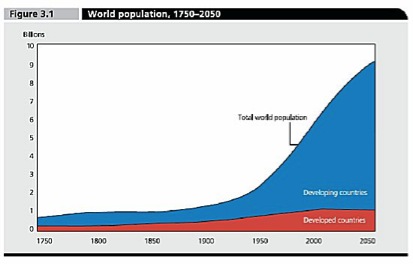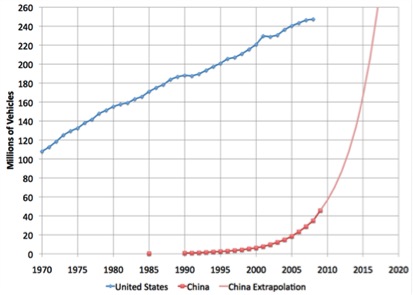More Demographic Reality!
In the post a couple of days ago I tried to give you some big picture information related to world population trends and aging. This is part of my ongoing “educational campaign” for demographic reality related to how we approach the world as individuals, organizations, and countries. Today I want to share to more graphs with you about how unprepared we are for the future of the world.
Population Growth 1750-2050
The figure below shows both historical and projected increases in population. Currently there are about 7 billion people on earth and that number is projected to rise to about 9 billion by mid-century and then perhaps level off. All of the projected population growth is likely to happen in the developing world. No population growth or a slight decline is projected in the developed countries of Europe, North America, Japan, and Australia/New Zealand. In 2050 there will be 8 billion people in the developing world.
What Happens When They Get Cars?
The next figure shows the number of vehicles (essentially cars and trucks) in the U.S. and the number of vehicles in China along with the projected growth in China over the next few years. I picked this slide because people from all over the world want cars when they “join the middle class”, and my bet is that cars are a pretty good marker for consumption of other energy and resource intensive items like refrigerators, TVs, personal computers, meat and microwave ovens. So even if the graph below over estimates the rise in car ownership in China (if anything it is an underestimate), what will the impact on world resource use be if a couple of billion more people join the middle class between now and 2050?
Thoughts About These Trends
I don’t begrudge anyone the desire to live a middle class developed world life with cars and other gizmos. To say folks in the developing world should fundamentally not have what we have seems hypocritical at best. So do we severely downsize and conserve in the developed world? Do we all become vegetarians, ride our bikes, live in small houses, and take public transportation? Even if we all cut our consumption of “stuff” by 50% or more, how long will it be until this level conservation is overwhelmed by the sheer number of people living “better” in the developing world? Are we headed towards some sort of total environmental and economic collapse, or should we start to discuss a combination of conservation, mitigation, and lesser of two evil choices (like nuclear power) to avoid collapse? If so what are the options and who decides? At some level we can compete country by country and face almost certain collapse, at another level we can collaborate creatively and perhaps get by. We should also keep in mind the words of Arnold Toynbee as we think about the future:
“Civilizations die from suicide, not from murder”
This entry was posted on Thursday, May 9th, 2013 at 5:22 am and is filed under Current Events. You can follow any responses to this entry through the RSS 2.0 feed. You can leave a response, or trackback from your own site.



